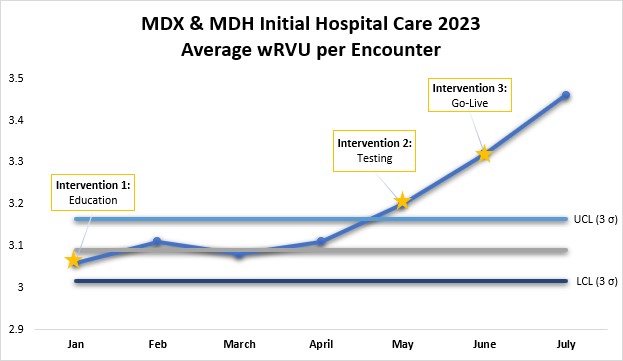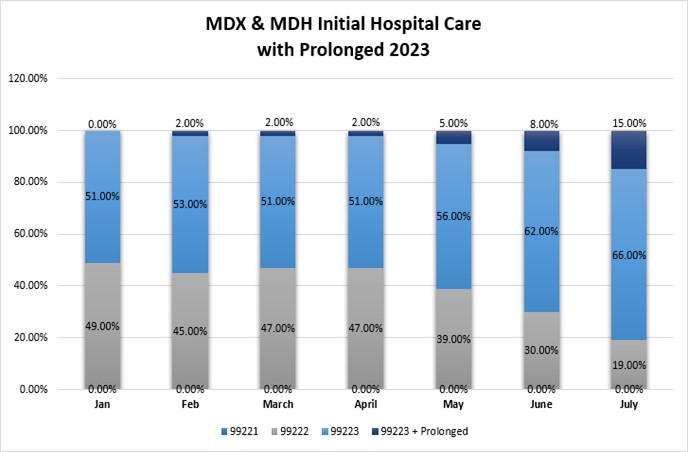Background: On January 1st, 2023, the AMA released updated CPT E&M codes and guidelines. While there were welcome aspects to these changes – including removing need for an extensive physical exam and making it easier to capture prolonged service time – healthcare systems were left grappling with a need to quickly respond to these complex changes.1,2 Our Hospitalist Division recognized that education alone would not result in substantial changes to our practices3. A strategically selected group of individuals – Divisional leadership (AD), Documentation Improvement specialist (PO), physician EPIC expert (LM), lean/six sigma methodology specialist (CM), nocturnist with external experience (DY), and a senior level physician coding auditor and revenue cycle specialist (RK) –created an H&P note template that is efficient to use and seamlessly integrated the updated guidelines.
Purpose: Educational efforts in Jan 2023 yielded no significant results (Figure 1). In March 2023, our group initiated bi-monthly working meetings to create an H&P template that accomplished three goals:1) To seamlessly integrate critical aspects of the billing guidelines without the need to reference external material.2) Accurately capture work already routinely being performed.3) Maintain the integrity of the H&P as a primary communication tool. We gathered best practice recommendations from other Divisions and external institutions. Four optional dropdowns were created:1) A Severity of Illness modifier 2) Complexity of Management modifier tailored to the most encountered scenarios.3) Data Review modifier.4) Time-based billing modifier that included prolonged service time.The first template was released in May 2023. Workgroup members utilized the draft template during admitting shifts to gain experience in its use. Face-to-face “just in time” education was provided to other providers determined to be “key change agents,” and their input and feedback was solicited. These actions served to optimize the template prior to Go-Live and reduce resistance to widespread adoption.3 Our coding auditor specialist analyzed submitted H&Ps for weaknesses in template verbiage. With the insights gained from intervention testing, we improved the usability, specificity, efficiency, and ease of use of the template. At Go-live, all commonly used shared H&P templates were updated to the new template, and the group was asked to use the new template for all initial encounters.
Description: Before Go-Live, we experienced an immediate increase in average wRVU/encounter because of beta testing. After June 2023 Go-Live, there was a further increase in average wRVUs (Figure 1).There was a continued rise in wRVUs in July 2023, which directly correlated with increased prolonged care code utilization (Figure 2).
Conclusions: Education alone is an insufficient strategy to allow for integration of complex changes into clinical practice. A strategically designed template is an effective tool to increase provider based revenue. A template should be designed with active input from the intended end-user and balance efficiency of use and revenue-generating additions.


